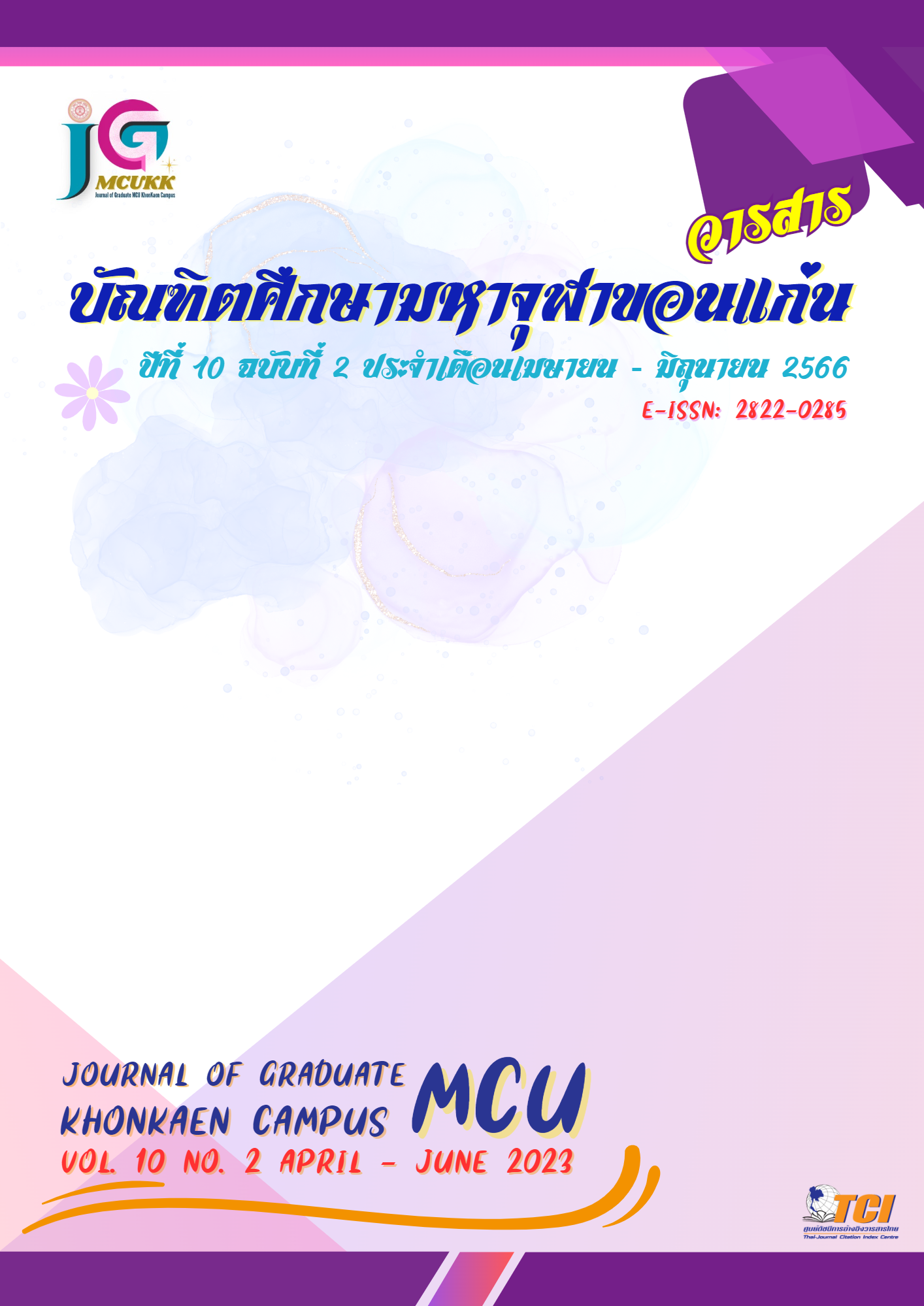Teaching for Cultivating Power Four of Students at Khao Luang Wittaya School Wang Saphung District Loei Province
Main Article Content
Abstract
This research aimed to study the teaching based on the four Iddhipada principles, examine the teaching results to cultivate the four Iddhipada, and propose the teaching and learning guidelines for developing Iddhipada four in students at Khao Luang Wittaya School, Wang Saphung District, Loei province. The sample group was 102 students
selected by using the stratified sampling method. The size of the sample group referred to Taro Yamane. The key informants comprised 24 student council members, administrators, and teachers, whom were selected with purposive sampling. Data collection was processed using a questionnaire and structured in-depth interviews. The collected data were used to analyze percentage, mean, Standard Deviation (S.D.), and content analysis. Results demonstrated that: the teaching based on four Iddhipada consisted of goal, vision and mission determination, education quality development plan, and annual operational plan setting founded on the community requirements, curriculum set up for all departments, promotion of continuing teacher development, the use of technology and innovations for on-site and on-line learning, results illustrated that the overall teaching for cultivating four Iddhipada was 4.38, and teaching guidelines to cultivate the four Iddhipada were proposed. All stakeholders should cooperate by playing their roles to their full potential. In addition, the administrators should lead the changes from the abstract to substantial development, and determine the identity, “Will Power, Effort, Stay Focus, Examination”. Moreover, teachers of all departments should set the lesson plan to cultivate the four Iddhipada for every semester of all academic years and have a systematic evaluation. At the same time, students must cooperate with every group. A standard evaluation tool should be utilized, and results must be summarized via communication systems. Moreover, results should be applied to the further development plan for the best practice.
Article Details

This work is licensed under a Creative Commons Attribution-NonCommercial-NoDerivatives 4.0 International License.
References
ไกรศร เจียมทอง. (2561). ทักษะของผู้บริหารสถานศึกษาในศตวรรษที่ 21 สังกัดสำนักงานเขตพื้นที่การศึกษามัธยมศึกษา เขต 32. (วิทยานิพนธ์ครุศาสตรมหาบัณฑิต). มหาสารคาม: มหาวิทยาลัยราชภัฏมหาสารคาม.
พระพรหมคุณาภรณ์ (ป.อ.ปยุตฺโต). (2545). ธรรมนูญชีวิต, (พิมพ์ครั้งที่ 46). กรุงเทพฯ: กรมศาสนา.
______. (2546). พจนานุกรมพุทธศาสตร์ ฉบับประมวลธรรม. (พิมพ์ครั้งที่ 12) กรุงเทพฯ: เอส.อาร์.พริ้นติ้งแมสโปรดักส์.
พระมหาบรรจง ติสรโณ (ศรีสุข). (2560). ศึกษาการประยุกต์ใช้หลักอิทธิบาทธรรม 4 ในการจัดการเรียน การสอนของโรงเรียนปริยัติคุณรสวิทยา อำเภอเมืองสุรินทร์ จังหวัดสุรินทร์. (วิทยานิพนธ์พุทธศาสตรมหาบัณฑิต). พระนครศรีอยุธยา: มหาวิทยาลัยมหาจุฬาลงกรณราชวิทยาลัย.
พระมหาชินกฤต จิรวํโส (รูปสะอาด). (2561). การประยุกต์ใช้หลักอิทธิบาท 4 ในการจัดการเรียนการสอนของนักเรียนชั้นประถมศึกษาปีที่ 5 โรงเรียนบ้านตูม ตำบลบ้านจันทน์ อำเภอบ้านดุง จังหวัดอุดรธานี. (วิทยานิพนธ์พุทธศาสตร์มหาบัณฑิต). พระนครศรีอยุธยา: มหาวิทยาลัยมหาจุฬาลงกรณราชวิทยาลัย.
พระมหาวิทวัฒน์ วิวฑฺฒนเมธี. (2561). การบริหารตามหลักอิทธิบาท 4 ในสถานศึกษาขั้นพื้นฐาน สังกัดสำนักงานเขตพื้นที่การศึกษาประถมศึกษากาฬสินธุ์ เขต 2. (วิทยานิพนธ์พุทธศาสตรมหาบัณฑิต). พระนครศรีอยุธยา: มหาวิทยาลัยมหาจุฬาลงกรณราชวิทยาลัย.
พระราชบัญญัติการศึกษาแห่งชาติ (ฉบับที่ 2). (2545, 19 ธันวาคม). ราชกิจจานุเบกษา เล่ม 119 ตอนที่ 123 ก. หน้า 14.
มหาจุฬาลงกรณราชวิทยาลัย. (2539). พระไตรปิฏกภาษาไทย ฉบับมหาจุฬาลงกรณราชวิทยาลัย. กรุงเทพฯ: มหาจุฬาลงกรณราชวิทยาลัย.
โรงเรียนเขาหลวงวิทยา. (2564). รายงานการประเมินตนเองของสถานศึกษา (SAR) โรงเรียนเขาหลวงวิทยา. (อัดสำเนา).
สมพร อินทรพาเพียร. (2560), การปรับใช้หลักอิทธิบาท 4 ในการเรียนของนักเรียนชั้นมัธยมศึกษาปีที่ 6 โรงเรียนสันป่าตองวิทยาคม จังหวัดเชียงใหม่. (วิทยานิพนธ์พุทธศาสตรมหาบัณฑิต). พระนครศรีอยุธยา: มหาวิทยาลัยมหาจุฬาลงกรณราชวิทยาลัย.

